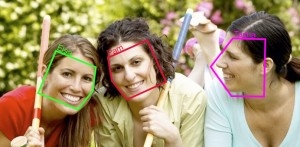Those who read this blog are more than likely among the group that shares some level of conviction (maybe not as strongly as I do!) that Augmented Reality is going to be important. We are a small minority, but April 2012 will represent an important historical milestone. Perhaps it is as important as the June 2009 release of Layar's AR browser in terms of demonstrating that AR has traction, has graduated from the laboratory, captured imaginations and will have huge commercial impacts.
In the past three weeks many more people are finally getting to see the signs that indicate how important Augmented Reality will be in the future. The curtain that formerly prevented people from knowing how much investment was truly happening is dropping. Major companies are now following Qualcomm and putting resources into AR. 
They are putting "skin in the game" and that's what it takes to convince many (including the mobile pundits such as Tomi Ahonen and Ajit Jaokar) that AR has passed a treshhold. In case you didn't catch it, Tomi posted on his blog, Communities Dominate Brands, on April 11, 2012 (probably the shortest blog he's ever written!) that he has seen the light and he can now believe that AR is the planet's 8th mass medium.
Twenty-eleven was a slow year for AR revenue growth but those who were paying attention could see small signs of the growing captial influx. Intel had already demonstrated its interest in AR by investing in Layar in late 2010 and in Olaworks in early 2007 and expanded its investments (e..g, in Total Immersion). Texas Instruments, Imagination Technologies, ARM, ST Ericsson and Freescale all revealed that they have established programs on their own or in partnership with AR companies to accelerate AR on mobile platforms.
But, with only a few exceptions, these announcements by semiconductor companies were "me too," forced by the apparent (media) successes of Qualcomm's Vuforia and Hewlett Packard's Aurasma. These last two companies have heavily contributed to the media's awareness of mobile AR, but, sadly, also contributed to the perceived image that AR is a gimmick.
We can now pinpoint the catalytic event when AR is taken more seriously: the 9:00 AM PDT April 4, 2012 announcement by Google that confirmed prolific rumors that it is indeed working on see-through head-mounted displays (posted on TechCrunch here). Many jumped to the conclusion that these are AR glasses, although the applications are not, strictly speaking, limited to AR. A blog called Glasses from Google calls them "a new paradigm in computing."
While the figures have not been (and never will be) disclosed by Google, I estimate that the company has already invested well over $4M, approximately ten percent of the entire AR industry revenues in 2011, to get to its current prototype (even one that reboots regularly). And (most likely) without reaching far beyond its internal intellectual properties and a few consultants. Note that, in light of the Project Glass announcement, the Google acquisition of Motorola Mobility for total of about $12.5 billion is very strategic. It surpasses the October 2011 $10 bilion Hewlett Packard acquisition of Autonomy by only a few billion dollars. Very big Skin in the Game.
While the global media has for 15 days steadily reported on and speculated about Project Glass, and the video broke social media records, this is not the only example that there have been and are new investments being made in mobile AR in April 2012. Tiny by financial standards, but significant developments nevertheless, include the Olaworks acquisition, and today Total Immersion has announced that Peter Boutros, a former Walt Disney VP will be its new president. And Google isn't the only company that's working on eyewear for information. For example, Oakley's Apri 17 announcement that it has been working on an eyewear project shouldn't have taken anyone by surprise but managed to make the headlines.
What and who is next?!
And how much skin will the next announcement be worth?
Without strong business cases this second question will be the most difficult to answer and, for this reason, it is a topic to which I have recently written another post.




